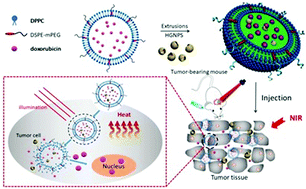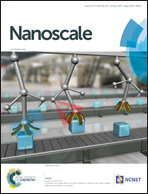The comparative effect of wrapping solid gold nanoparticles and hollow gold nanoparticles with doxorubicin-loaded thermosensitive liposomes for cancer thermo-chemotherapy†
Abstract
Since conventional chemotherapy is a systemic treatment that affects the body globally and will not concentrate inside the tumor, it causes adverse side effects to patients. In this study, doxorubicin (DOX) together with solid gold nanoparticles (GNPs) or hollow gold nanoparticles (HGNPs), respectively, is loaded inside thermosensitive liposomes (GNPs&DOX-TLs and HGNPs&DOX-TLs), where the GNPs and HGNPs act as a “nanoswitch” for killing tumor cells directly by hyperthermia and triggering DOX release from TLs in the tumor quickly by near infrared laser (NIR) illumination. In addition, this study investigated the photothermal transformation ability, NIR triggered drug release behavior, and the intracellular uptake and cytotoxicity of breast tumor cells and the thermo-chemotherapy mediated by the co-delivery of GNPs&DOX-TLs and HGNPs&DOX-TLs. GNPs and HGNPs had very different light-to-heat transduction efficiencies, while the hollow HGNPs had the advantage of NIR surface plasmon tunability, resulting in the photothermal ablation of tumors with 800 nm light penetration in tissue. The prepared HGNPs&DOX-TLs exhibited a spherical shape with a diameter of 190 nm and a ξ potential of −29 mV, which were steadily dispersed for at least one month. The co-encapsulated DOX was released under hyperthermia caused by NIR-responsive HGNPs and the local drug concentration increased along with the disintegration of the liposomal membrane. This co-delivery of HGNPs&DOX-TLs produced a synergistic cytotoxicity response, thereby enhancing anticancer efficacy 8-fold and increasing the survival time compared to GNPs&DOX-TLs. This work suggested that the co-delivery of HGNPs&DOX-TLs followed by burst-release of DOX using NIR-responsive HGNPs sensitized cancer cells to the chemotherapeutic compound, which provided a novel concept for the combination strategy of chemotherapy and photothermal therapy. These results suggest that the markedly improved therapeutic efficacy and decreased systemic toxicity of the NPs presented in this study hold significant potential for future cancer treatment.

- This article is part of the themed collection: International Year of the Periodic Table: Precious metals for cancer treatment


 Please wait while we load your content...
Please wait while we load your content...